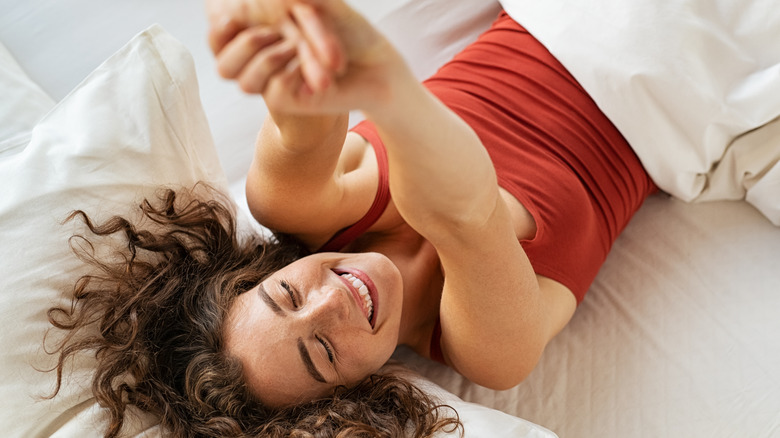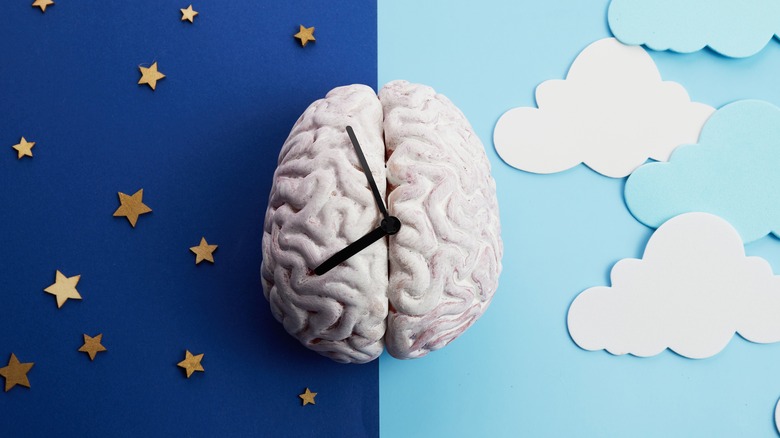Getting Good Rest Every Night May Boil Down To One Factor
Wishing for more beauty sleep? You're not the only one. For most of us, it's tough to keep up a perfect nap schedule, especially because we all have our own idiosyncrasies and unique sleep challenges. Some of us may feel like night owls, which can make getting up every day for work into a neverending nightmare. On the other hand, natural morning people may find their vim and vigor waning throughout the day, making it tough for them to stay up late for social occasions.
Unfortunately, when we push ourselves into a sleep schedule that doesn't fit our rhythm, it can leave us feeling drained and unproductive. "If you don't have the option of falling asleep when your brain really wants to ... you probably will not fall asleep. And therefore, you'll be sleep-deprived the next day, and that has profound implications for relationships with other people because you're irritable. It also does not impress the employer because you've been late to work. Whatever your work schedule is, it may or may not work with your circadian rhythm," chronobiologist Dr. Chris Jones tells the podcast "7 Domains of Women's Health" from the University of Utah Health.
For some, the answer may be shifting your bedtime earlier for better rest and health benefits. But others may simply find themselves laying awake, trying to calm nightly anxiety. For best results, we need a way to parse our individual biology and tailor our schedules for peak rest and productivity. Luckily, there may be hope on the horizon. In his 2016 book, "The Power of When," Dr. Michael Breus proposes just such a system, which he refers to as the sleep chronotypes.
What are sleep chronotypes?
To put it simply, chronotypes describe the natural sleep pattern that your body wants to follow — i.e., whether you're a night owl, an early bird, or something in between. The theory digs into these inclinations further to describe your balance of rest and productivity in detail, along with offering recommended schedules for better sleep-life balance. These chronotypes are determined by a number of factors, such as hormone levels and your current age (via the Sleep Foundation). To account for this, Dr. Breus' chronotype models include notes on everything from diet and caffeine intake to the ideal time of day to exercise. A 2016 review in the academic journal Sleep suggests that there's also a strong genetic component to chronotypes, meaning your sleep tendencies may follow in your parents' footsteps.
To clearly differentiate the various energy patterns that dictate our sleep and productivity, chronotypes are broken into four categories, represented by animals: lion, bear, wolf, and dolphin. Each one indicates a different natural sleep cycle and suggests a schedule that will work holistically with your body's rhythms. So, how can you use your chronotype to get the best rest possible?
First and foremost, you need to determine which chronotype fits you. If you don't know already, Dr. Breus' website, The Sleep Doctor, offers an online chronotype quiz that can help you figure it out, especially since the results might surprise you. Bear in mind, though, that your chronotype can actually change over time as you go through different stages of your life, so it can help to periodically recheck your chronotype to make sure your schedule and sleep habits align with your current needs.
How to get the best rest for your chronotype
Lions are quintessential morning people. With high energy early in the day, they're most productive when they hit the ground running. However, this can mean that lions wear out by the late afternoon and evening, so it's important they get enough rest to power through their day. Lions should try to get a full eight hours of sleep, say from 10 p.m. to 6 a.m. (via Casper).
Bears are heavy sleepers who work best with solid hibernation each night. This can make bear chronotypes a little slower to wake, but they hit their stride in the late morning and can get a lot done in the hours around lunch. However, their energy winds down again in the late afternoon, preparing for another night of deep sleep. Ideally, bears should get a lot of rest, with a suggested schedule of 11 p.m. to 7 a.m. (via SleepScore).
Wolf chronotypes are night owls, becoming more energetic and creative as the day goes by. This means they can be groggy in the morning and should avoid scheduling important or detail-oriented tasks until noon or later (via Healthline). To make the most of their energy and focus, wolves benefit from a later bedtime, with a recommended sleep schedule between midnight and 7:30 a.m.
Dolphins are the hyperactive, borderline insomniac chronotype (via Psychology Today). Likely to experience sleep troubles like a noisy brain at bedtime, dolphins can suffer from erratic ups and downs throughout their day. To harness these bursts of energy, dolphins should aim for flexibility in their routine. But before sleeping, they need focused time to unwind and relax. Dolphins should try getting shuteye between 11:30 p.m. and 6:30 a.m.


